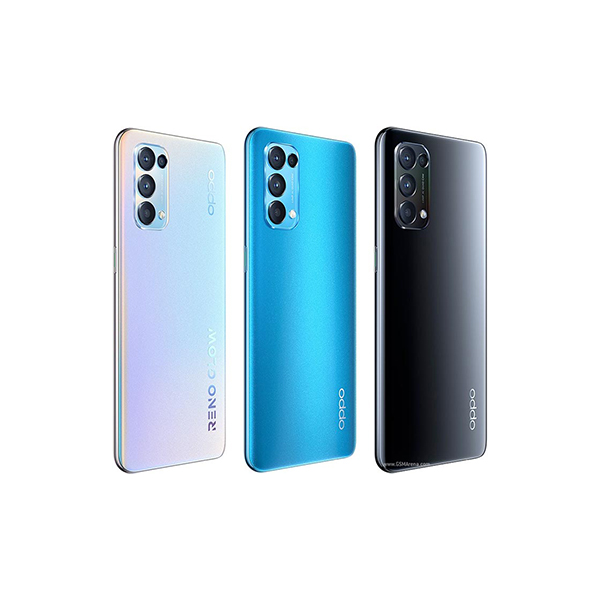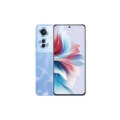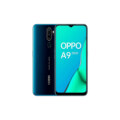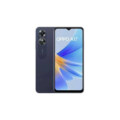Oppo Reno5 5G



Specs
General
| Device Type | Oppo phone |
| Announced | 10 December, 2020 |
| Released | 10 December, 2020 |
| Status | Available |
Design
| Dimensions | 159.1 x 73.4 x 7.9 mm |
| Weight | 172 g |
| Colors | Galactic Silver, Azure Blue, Starry Black |
Display
| Refresh Rate | 90 Hz |
| Display Type Display Technology => A number of display technologies and types used in mobile phones => TFT (Thin Film Transistor), IPS (In-Place Switching), OLED (Organic Light Emitting Diode), AMOLED (Active-Matrix Organic Light-Emitting Diode), Super AMOLED (an even advanced version of AMOLED), Resistive Touchscreen (Resistive touchscreens contain two layer of conductive material with a very small gap between them which acts as a resistance), Capacitive Touchsceen (Capacitive touchscreen technology consists of a layer of glass coated with a transparent conductor) | Super AMOLED |
| Size | 6.55 inches (16.64 cm) |
| Resolution | 1080x2400 px (FHD+) |
| Display Colors Display Colors is refers to the number of different shades of colors that the screen is capable of displaying => 64K colors, 256K colors and 16 million colors, Obviously 16M is highest available range of colors and better than others. | 16M colors |
| Pixel Density Pixel Density (PPI) is refers to the concentration of pixels on a particular display, measured in pixels per inch (ppi). Pixel density is calculated by dividing the diagonal pixel resolution of a display by its diagonal size, higher pixel density better display quality. | 402 ppi |
| Touch Screen | Capacitive Touchscreen, Multi-touch |
| Display Protection Display Protection => Gorilla Glass is a special alkali-aluminosilicate glass shield with exceptional damage resistance that helps protect mobile displays from scratches, drops, and bumps of everyday use, It is always better to go for a smartphone with Gorilla Glass for that added protection and peace of mind. | Corning Gorilla Glass 5 |
| Features | 800 nits |
| Secondary Display | No |
Camera
| Front Camera | 32 MP, f/2.4, 26mm (wide), 1/2.8", 0.8µm |
| Camera Setup | Quad |
| Main Camera Camera is able to capture photographs and usually videos, The most important characteristics of a camera are the resolution (measured in megapixels), lens focus type (fixed or automatic), higher megapixel cameras are known to capture higher quality photos, but not always a good measurement of the photos quality. |
64 MP, f/1.7, 26mm (wide), PDAF 8 MP, f/2.2, 119˚ (ultrawide), 1/4.0", 1.12µm 2 MP, f/2.4, (macro) 2 MP, f/2.4, (depth) |
| Image | 9000 x 7000 Pixels |
| Video | 4K@30fps, 1080p@30/60/120fps; gyro-EIS, HDR |
| Camera Features | Exposure compensation, ISO control |
| Flash Flash Light => There is commonly two types of flash lights are used in camera mobile phones, LED Flash (LED flash offers lower power consumption with drive circuitry that takes up very little room, LEDs can be strobed faster than any other light source), Xenon Flash (xenon flash produces an extremely intense full-spectrum white light for a very short duration) | LED flash, HDR, panorama |
Hardware
| Operating System OS => Every computer system run on a base software called Operating System (OS). Operating System controls all basic operations of the computer (such as smartphone, PDAs, tablet computers and other handheld devices). The Operating System allows the user to install and run third party applications (apps), apps are used to add new functionality to the device. | Android 11 |
| Chipset Chipset is a group of integrated circuits designed to perform one or a more dedicated functions, often with real time computing constraints, Popular smartphones are equipped with more advanced embedded chipsets that can do many different tasks depending on their programming. | MediaTek Dimensity 1000 Plus MT6889Z |
| CPU CPU (Central Processing Unit) mostly known as processors, CPU processes instructions in order to carry out certain functions that make your device operate properly. Processors are often described as the brain of computers, smartphones and tablets, Smartphones and tablets rely on processors to carry out their every task, Processors are an incredibly important factor in selecting any type of computing device, including your smartphone. | Octa core (2.6 GHz, Quad core, Cortex A77 + 2 GHz, Quad core, Cortex A55) |
| Architecture | 64 bit |
| Fabrication | 7 nm |
| GPU GPU (Graphics Processing Unit) is a single-chip processor designed to rapidly manipulate and alter memory to accelerate the creation of images in a frame buffer intended for output to a display, This includes things such as lighting effects, object transformations, and 3D motion. | Mali-G77 MC9 |
| RAM (Memory) RAM (Random Access Memory) is a type of computer memory that can be accessed randomly, any byte of memory can be accessed without touching the preceding bytes that allows information to be stored and accessed quickly from random locations. RAM is the most common type of memory found in computer systems, smartphones, tablets and other electronic devices. | 8 GB |
| Internal Storage Internal Storage is a data storage space (flash memory) mostly used in smartphones, tablets and other electronic devices where operating system, apps, music, photos, videos, files and other user data Is stored. | 128 GB |
| Card Slot Memory Card Slot is a special slot for inserting a memory card. Memory cards allow you to expand the phone's built-in memory, A memory card (sometimes called a flash memory card or a storage card) is a small storage medium used to store data such as text, pictures, audio, and video, for use on small, portable or remote computing devices such as mobile phones, mp3 players, digital cameras. | |
| Sensors Sensors are electronic components that detects and responds to some type of input from the physical environment. The specific input could be light, heat, motion, moisture, pressure and location, The output is generally a signal that is converted to use in computing systems, a location sensor, such as a GPS receiver is able to detect current location of your electronic device. | Fingerprint (under display, optical), accelerometer, gyro, proximity, compass |
Network
| SIM TYPE SIM (Subscriber Identity Module) is a small card that contains mobile network subscriber's account information. This allows the phone using the card to attach to a mobile network. The SIM card is most commonly associated with GSM and UMTS mobile networks. Moving a SIM card from one phone to another allows a subscriber to switch mobile phones without having to contact their mobile network carrier. SIM cards can also be used by a phone to store limited amounts of data, such as phone numbers and text messages. | Nano SIM |
| SIM Technology | Dual Sim, Dual Standby |
| 2G Network | GSM 850 / 900 / 1800 / 1900 |
| 3G Network | HSDPA 850 / 900 / 1900 / 2100 |
| 4G Network | LTE band 3(1800), 7(2600), 38(2600), 39(1900), 40(2300), 41(2500) |
| 5G Network |
FDD N1 / N3 / N7 / N28 TDD N38 / N40 / N41 / N77 / N78 |
Multimedia
| FM Radio | |
| Stereo Speakers | NO |
| Loudspeaker | YES |
| Audio Jack | 3.5mm Audio Jack |
| Audio Features | 24-bit/192kHz Hi-Res audio |
Connectivity
| Wi-fi Wi-Fi is a popular wireless networking technology using radio waves to provide high-speed network connections that allows devices to communicate without cords or cables, Wi-Fi is increasingly becoming the preferred mode of internet connectivity all over the world. | Wi-Fi 6 (802.11 b/g/n/ac/ax) 5GHz, MIMO |
| Bluetooth Bluetooth is a wireless communications technology for exchanging data between mobile phones, headsets, computers and other network devices over short distances without wires, Bluetooth technology was primarily designed to support simple wireless networking of personal consumer devices. | v5.1 with A2DP, LE, apt-X HD |
| GPS GPS The Global Positioning System is a satellite-based radio navigation system, GPS permits users to determine their position, velocity and the time 24 hours a day, in all weather, anywhere in the world, In order to locate your position, your device or GPS receiver must have a clear view of the sky. | A-GPS support & Glonass, BDS, GALILEO |
| USB | USB Type-C, USB On-The-Go |
| EDGE EDGE (Enhanced Data GSM Environment) is a wireless network technology generally considered the next step in the 2G network offers data transfer rates up to four times faster than ordinary GSM networks, Generally, EDGE is used for the purpose of wireless data transfer, such as sharing pictures and videos or browsing the Internet via a mobile phone connection. | |
| GPRS GPRS (General Packet Radio Service) is a packet oriented mobile data service on the 2G and 3G cellular communication system's global system for mobile communications (GSM), Generally, GPRS is used for the purpose of wireless data transfer, such as sharing pictures and videos or browsing the Internet via a mobile phone connection. | |
| Speed | 3G (HSPA 42.2/5.76 Mbps), 4G LTE-A |
| Wi-fi Hotspot | |
| NFC NFC (Near field communication) is a set of standards for smartphones and similar devices to establish peer-to-peer radio communications with each other by touching them together or bringing them into proximity, usually no more than a few inches. |
Features
| Messaging | SMS(threaded view), MMS, Email, Push Mail, IM |
| Web Browser Web Browser => a web browser is a software application used to locate, retrieve and display content on the World Wide Web, including Web pages, images, video and other files, The primary function of a web browser is to render HTML, the code used to design or markup webpages. | HTML5 |
| Games | Built-in + Downloadable |
| Torch |
Battery
| Battery Type Battery Type => Cell phones run on various kinds of batteries depending on the manufacturer, phone size or shape and features. There are basically four types of cell phone batteries => Lithium Polymer, Lithium Ion, Nickel Metal Hydride and Nickel Cadmium. | Li-Ion (Lithium Ion) |
| Capacity Battery Capacity is a measure (typically in Amp-hr) of the charge stored by the battery, and is determined by the mass of active material contained in the battery. The battery capacity represents the maximum amount of energy that can be extracted from the battery under certain conditions. | 4310 mAh |
| Placement | Non-removable |
| Wireless Charging Wireless Charging (Inductive Charging) uses an electromagnetic field to transfer energy between two objects. This is usually done with a charging station. Energy is sent through an inductive coupling to an electrical device, which can then use that energy to charge batteries or run the device. | No |
| Extra |
Fast charging 50W Reverse charging SuperVOOC |
Oppo Reno5 5G Detailed Review
The Oppo Reno5 5G is part of Oppo’s popular Reno series, known for its stylish design, solid performance, and camera capabilities. Released in early 2021, the Reno5 5G offers 5G connectivity, making it a future-proof option for those looking to stay ahead in the mobile network game. Here’s a detailed review of the Oppo Reno5 5G, covering its design, display, performance, camera, battery life, and software, along with its pros and cons.
Design and Build Quality
- Aesthetics: The Oppo Reno5 5G boasts a sleek and modern design with a slim profile and a lightweight build. The device has a premium feel, thanks to its glass back and metal frame. The Reno Glow finish on the back adds a shimmering effect that changes color under different lighting conditions, making the phone stand out visually.
- Build Quality: The phone feels solid and well-built, with a sturdy construction that suggests durability. The glass back is Gorilla Glass 5, providing some resistance to scratches, although it can be prone to fingerprints and smudges.
- Ergonomics: Weighing just 172 grams and with a thickness of 7.9mm, the Reno5 5G is comfortable to hold and use, even for extended periods. The buttons are well-placed and provide a satisfying click, while the in-display fingerprint sensor is fast and reliable.
Conclusion: The Oppo Reno5 5G impresses with its premium design, lightweight build, and solid construction. It’s a phone that looks as good as it feels.
Display
- Size and Type: The device features a 6.43-inch AMOLED display with a resolution of 2400 x 1080 pixels (Full HD+). The screen has a 90Hz refresh rate, offering a smoother visual experience compared to standard 60Hz displays.
- Quality: The AMOLED display delivers vibrant colors, deep blacks, and excellent contrast, making it ideal for watching videos, gaming, and browsing. The 90Hz refresh rate enhances the overall fluidity of the user interface, providing a smoother experience when scrolling and gaming.
- Brightness and Features: The screen is bright enough for outdoor use, with a peak brightness of around 750 nits. The device also supports HDR10+, enhancing the viewing experience with compatible content.
Conclusion: The display on the Oppo Reno5 5G is one of its standout features, offering vibrant visuals, a high refresh rate, and excellent brightness levels, making it a pleasure to use.
Performance
- Processor: The Oppo Reno5 5G is powered by the Qualcomm Snapdragon 765G chipset, a mid-range processor with 5G capabilities. It’s coupled with 8GB of RAM and 128GB of internal storage, ensuring smooth performance across various tasks.
- General Performance: The Snapdragon 765G is more than capable of handling everyday tasks such as browsing, social media, and multimedia consumption. It also performs well in gaming, running most titles smoothly, although it might struggle with the most graphically demanding games at the highest settings.
- Multitasking and Storage: With 8GB of RAM, multitasking is seamless, and apps stay in memory longer without needing to reload. The 128GB of storage should be sufficient for most users, though there’s no option for expandable storage via microSD card.
Conclusion: The Oppo Reno5 5G delivers strong performance for a mid-range device, with the Snapdragon 765G providing a smooth and responsive experience for both everyday use and gaming.
Camera
- Rear Camera Setup: The phone features a quad-camera setup on the back, consisting of a 64MP primary sensor, an 8MP ultra-wide-angle lens, a 2MP macro lens, and a 2MP depth sensor.
- Front Camera: The front-facing camera is a 32MP sensor, housed in a small punch-hole cutout.
- Camera Performance: The 64MP main camera captures detailed and vibrant photos in good lighting conditions. The ultra-wide camera offers a broader perspective, though with some noticeable distortion at the edges. The macro and depth sensors are less impressive but add versatility to the camera setup. Low-light performance is decent, especially with the help of Oppo’s Night Mode, which enhances detail and reduces noise. The front camera takes sharp and clear selfies, making it a good choice for selfie enthusiasts.
Conclusion: The camera system on the Oppo Reno5 5G is versatile and capable, especially in good lighting conditions. While the additional sensors are not as strong, the primary camera and front-facing camera deliver solid results.
Battery Life
- Capacity: The Oppo Reno5 5G is equipped with a 4300mAh battery, which is sufficient for a full day of moderate use.
- Charging: One of the highlights of the Reno5 5G is its 65W SuperVOOC 2.0 fast charging. This technology allows the battery to charge from 0 to 100% in just about 35 minutes, which is incredibly convenient for users on the go.
- Battery Performance: With moderate use, including browsing, social media, video streaming, and some gaming, the battery easily lasts through a full day. Power users might find themselves needing a top-up towards the end of the day, but with 65W fast charging, this is hardly a concern.
Conclusion: The battery life on the Oppo Reno5 5G is solid, and the 65W fast charging is a game-changer, making it one of the best features of the device.
Software and Features
- Operating System: The Oppo Reno5 5G runs on ColorOS 11.1, based on Android 11. ColorOS is known for its rich customization options, including themes, icon styles, and animations.
- Software Experience: The software is smooth and responsive, with plenty of features to enhance the user experience. Oppo has also kept the bloatware to a minimum, which is a plus. Features like FlexDrop (for multitasking) and Three-finger Translate (powered by Google Lens) add to the device’s utility.
Conclusion: ColorOS 11.1 on the Oppo Reno5 5G offers a refined and feature-rich experience, with plenty of customization options and useful features to enhance everyday use.
Pros & Cons
Pros:
- Sleek Design: The Oppo Reno5 5G looks and feels premium, with a stylish design and lightweight build.
- Vibrant AMOLED Display: The 90Hz AMOLED display offers vibrant colors, deep blacks, and smooth visuals.
- Strong Performance: The Snapdragon 765G chipset delivers solid performance for everyday tasks and gaming.
- 65W Fast Charging: SuperVOOC 2.0 fast charging is incredibly fast, charging the phone fully in just about 35 minutes.
- Capable Cameras: The 64MP main camera and 32MP front camera perform well, especially in good lighting conditions.
Cons:
- No Expandable Storage: The lack of microSD card support means users are limited to the internal storage.
- Average Low-Light Camera Performance: While decent, low-light performance is not as strong as in some competitors.
- Plastic Frame: Despite the premium design, the use of a plastic frame might not appeal to everyone.

Conclusion
The Oppo Reno5 5G is a well-rounded mid-range smartphone that offers a compelling combination of design, display quality, performance, and camera capabilities. The 65W SuperVOOC 2.0 fast charging is a standout feature, making it ideal for users who need their phone to be ready to go at a moment’s notice. While it has some limitations, such as the lack of expandable storage and average low-light camera performance, it still provides excellent value for its price. Overall, the Oppo Reno5 5G is a strong contender in the mid-range market, particularly for users who prioritize design, fast charging, and a good display.
Review
Disclaimer Note
All prices in Pakistan is updated daily from the price list provided by local shops and dealers but we can not guarantee that the information / price on this page is 100% correct (Human error is possible), always visit your local shop for exact cell phone cost & rate.














